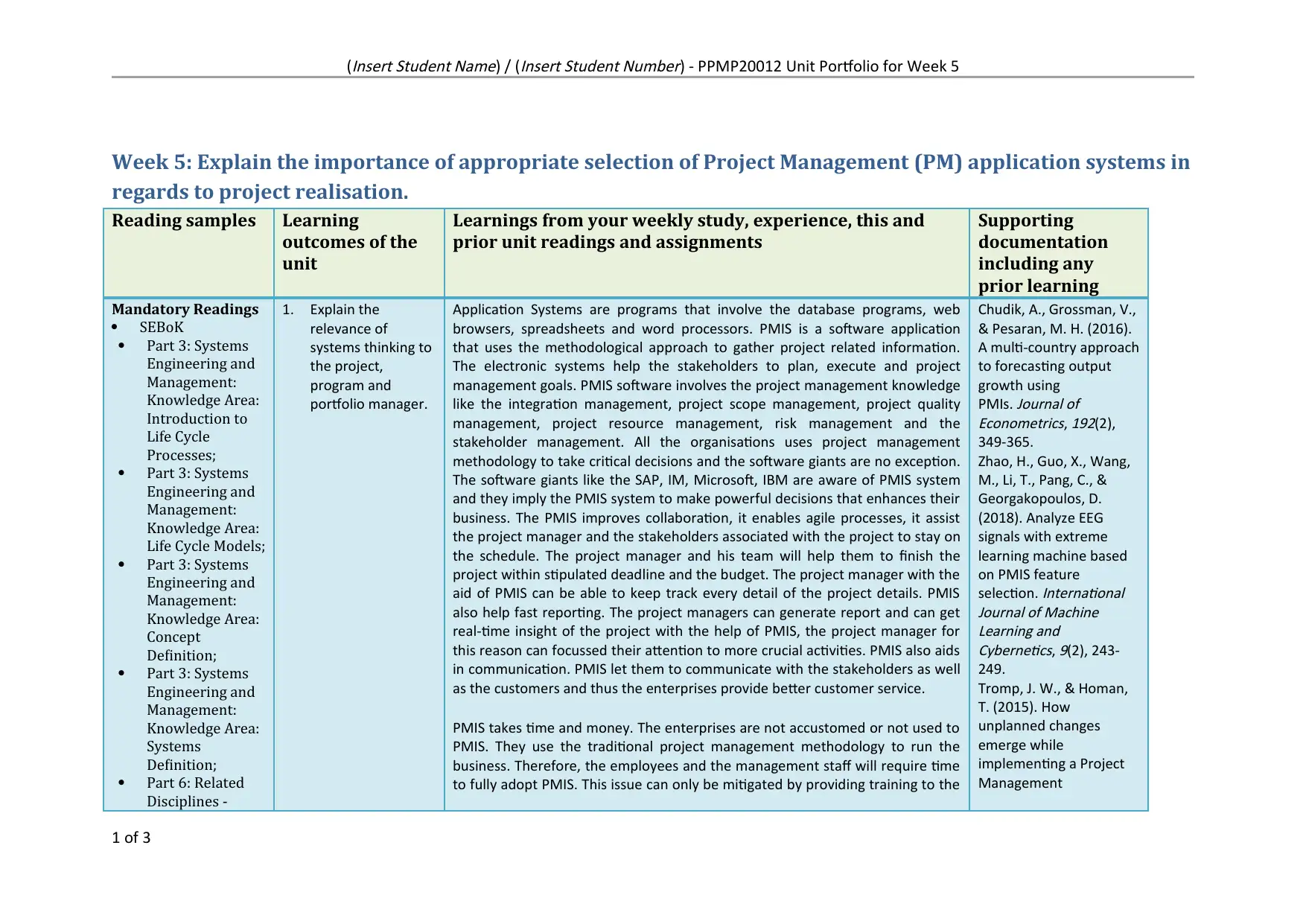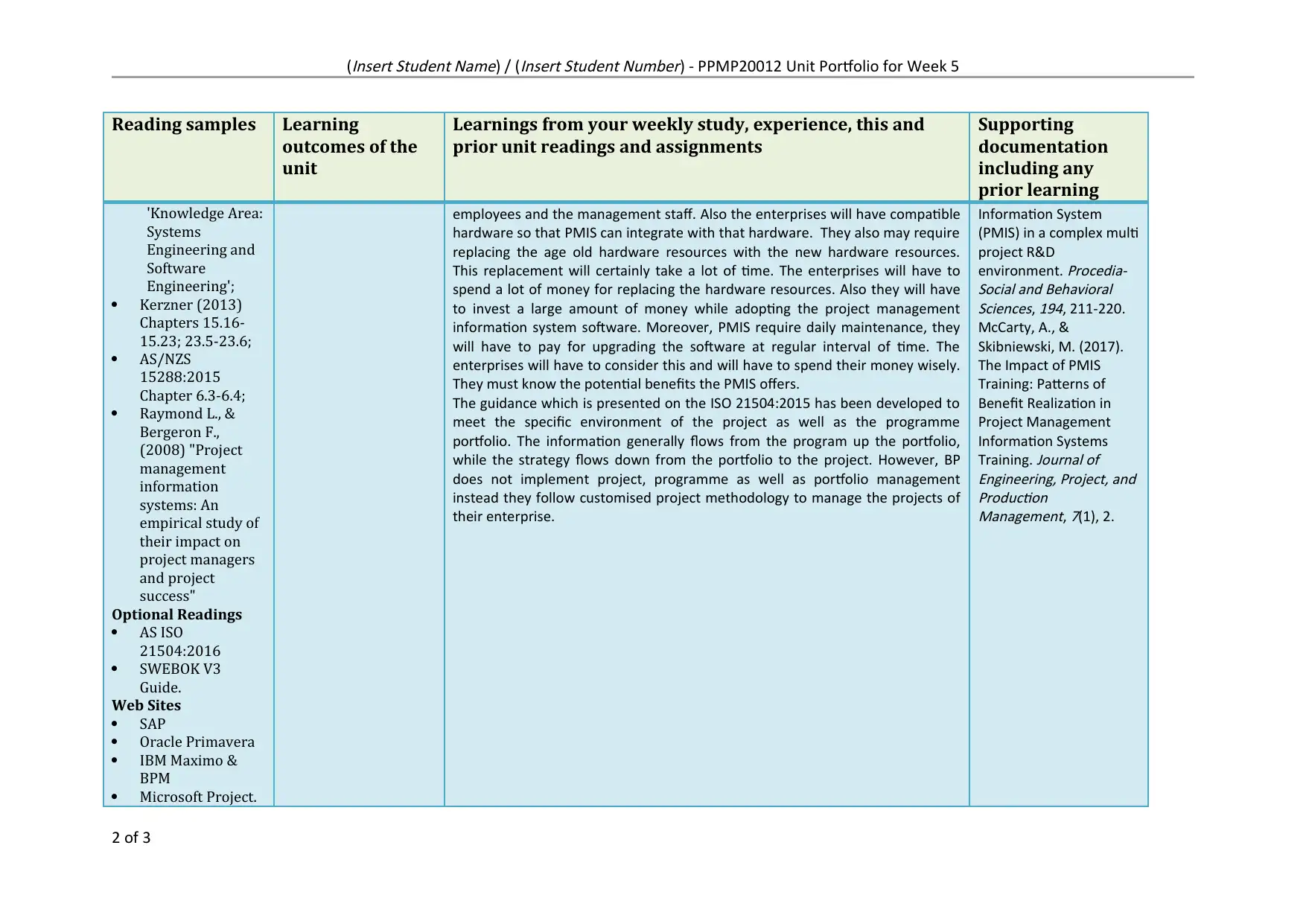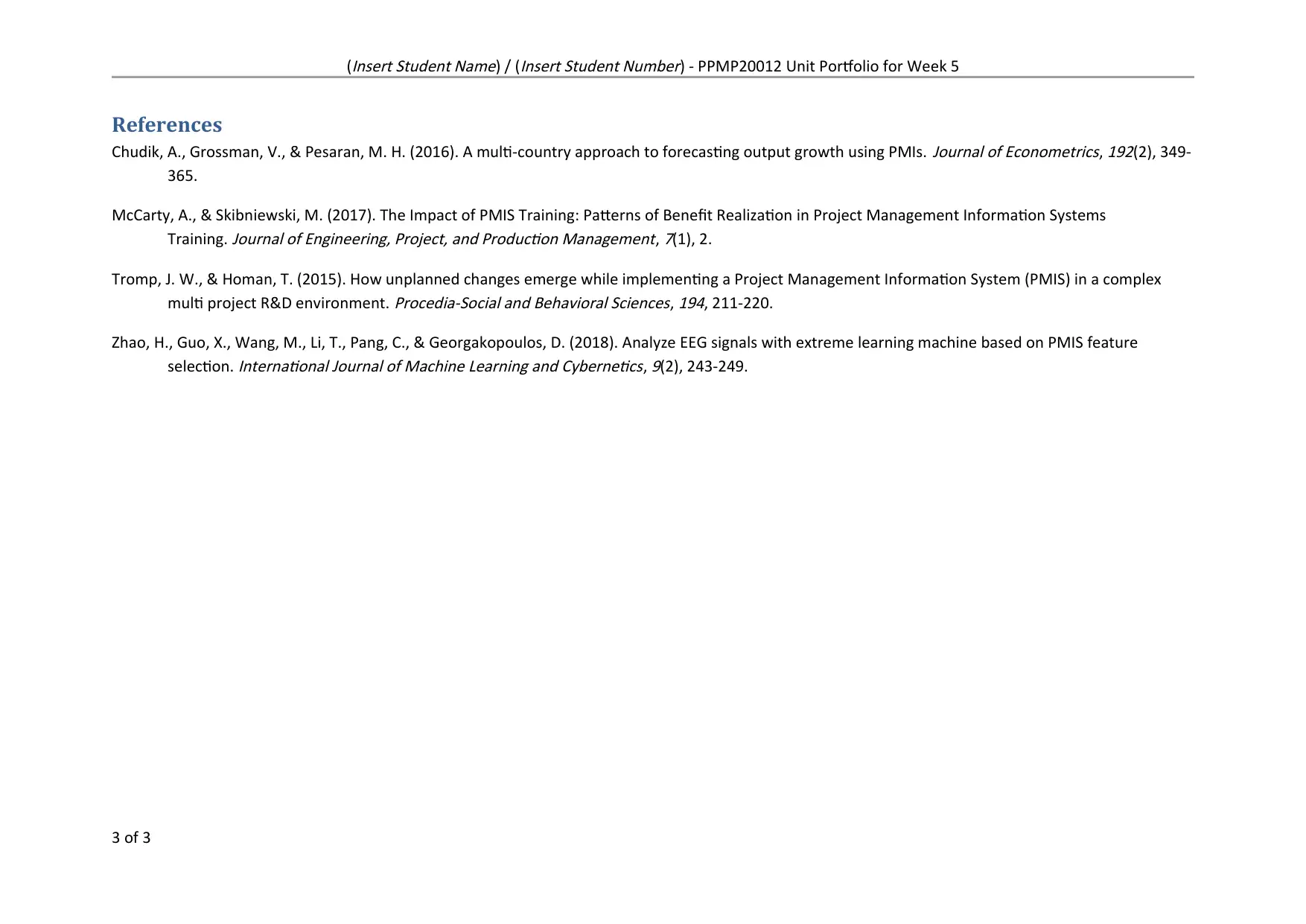PPMP20012 Unit Portfolio Week 5: PM Application Systems Analysis
VerifiedAdded on 2021/06/17
|3
|1138
|313
Report
AI Summary
This report, prepared for PPMP20012, explores the critical role of Project Management (PM) application systems, particularly Project Management Information Systems (PMIS), in achieving successful project outcomes. It emphasizes the importance of selecting appropriate PM systems, detailing their benefits, such as improved collaboration, agile processes, and enhanced stakeholder communication. The report highlights how PMIS aids in efficient planning, execution, and monitoring, enabling project managers to stay on schedule and within budget. It also acknowledges the challenges associated with PMIS implementation, including costs, training requirements, and the need for compatible hardware. Furthermore, the report references relevant readings, including SEBoK, Kerzner, and AS/NZS standards, to provide a comprehensive understanding of PMIS within the broader context of project, program, and portfolio management. Finally, the report outlines the significance of systems thinking for project, program and portfolio managers.

(
Insert Student Name) / (
Insert Student Number) - PPMP20012 Unit Portfolio for Week 5
Week 5: Explain the importance of appropriate selection of Project Management (PM) application systems in
regards to project realisation.
Reading samples Learning
outcomes of the
unit
Learnings from your weekly study, experience, this and
prior unit readings and assignments
Supporting
documentation
including any
prior learning
Mandatory Readings
SEBoK
Part 3: Systems
Engineering and
Management:
Knowledge Area:
Introduction to
Life Cycle
Processes;
Part 3: Systems
Engineering and
Management:
Knowledge Area:
Life Cycle Models;
Part 3: Systems
Engineering and
Management:
Knowledge Area:
Concept
Definition;
Part 3: Systems
Engineering and
Management:
Knowledge Area:
Systems
Definition;
Part 6: Related
Disciplines -
1. Explain the
relevance of
systems thinking to
the project,
program and
portfolio manager.
Application Systems are programs that involve the database programs, web
browsers, spreadsheets and word processors. PMIS is a software application
that uses the methodological approach to gather project related information.
The electronic systems help the stakeholders to plan, execute and project
management goals. PMIS software involves the project management knowledge
like the integration management, project scope management, project quality
management, project resource management, risk management and the
stakeholder management. All the organisations uses project management
methodology to take critical decisions and the software giants are no exception.
The software giants like the SAP, IM, Microsoft, IBM are aware of PMIS system
and they imply the PMIS system to make powerful decisions that enhances their
business. The PMIS improves collaboration, it enables agile processes, it assist
the project manager and the stakeholders associated with the project to stay on
the schedule. The project manager and his team will help them to finish the
project within stipulated deadline and the budget. The project manager with the
aid of PMIS can be able to keep track every detail of the project details. PMIS
also help fast reporting. The project managers can generate report and can get
real-time insight of the project with the help of PMIS, the project manager for
this reason can focussed their attention to more crucial activities. PMIS also aids
in communication. PMIS let them to communicate with the stakeholders as well
as the customers and thus the enterprises provide better customer service.
PMIS takes time and money. The enterprises are not accustomed or not used to
PMIS. They use the traditional project management methodology to run the
business. Therefore, the employees and the management staff will require time
to fully adopt PMIS. This issue can only be mitigated by providing training to the
Chudik, A., Grossman, V.,
& Pesaran, M. H. (2016).
A multi-country approach
to forecasting output
growth using
PMIs.
Journal of
Econometrics,
192(2),
349-365.
Zhao, H., Guo, X., Wang,
M., Li, T., Pang, C., &
Georgakopoulos, D.
(2018). Analyze EEG
signals with extreme
learning machine based
on PMIS feature
selection.
International
Journal of Machine
Learning and
Cybernetics,
9(2), 243-
249.
Tromp, J. W., & Homan,
T. (2015). How
unplanned changes
emerge while
implementing a Project
Management
1 of 3
Insert Student Name) / (
Insert Student Number) - PPMP20012 Unit Portfolio for Week 5
Week 5: Explain the importance of appropriate selection of Project Management (PM) application systems in
regards to project realisation.
Reading samples Learning
outcomes of the
unit
Learnings from your weekly study, experience, this and
prior unit readings and assignments
Supporting
documentation
including any
prior learning
Mandatory Readings
SEBoK
Part 3: Systems
Engineering and
Management:
Knowledge Area:
Introduction to
Life Cycle
Processes;
Part 3: Systems
Engineering and
Management:
Knowledge Area:
Life Cycle Models;
Part 3: Systems
Engineering and
Management:
Knowledge Area:
Concept
Definition;
Part 3: Systems
Engineering and
Management:
Knowledge Area:
Systems
Definition;
Part 6: Related
Disciplines -
1. Explain the
relevance of
systems thinking to
the project,
program and
portfolio manager.
Application Systems are programs that involve the database programs, web
browsers, spreadsheets and word processors. PMIS is a software application
that uses the methodological approach to gather project related information.
The electronic systems help the stakeholders to plan, execute and project
management goals. PMIS software involves the project management knowledge
like the integration management, project scope management, project quality
management, project resource management, risk management and the
stakeholder management. All the organisations uses project management
methodology to take critical decisions and the software giants are no exception.
The software giants like the SAP, IM, Microsoft, IBM are aware of PMIS system
and they imply the PMIS system to make powerful decisions that enhances their
business. The PMIS improves collaboration, it enables agile processes, it assist
the project manager and the stakeholders associated with the project to stay on
the schedule. The project manager and his team will help them to finish the
project within stipulated deadline and the budget. The project manager with the
aid of PMIS can be able to keep track every detail of the project details. PMIS
also help fast reporting. The project managers can generate report and can get
real-time insight of the project with the help of PMIS, the project manager for
this reason can focussed their attention to more crucial activities. PMIS also aids
in communication. PMIS let them to communicate with the stakeholders as well
as the customers and thus the enterprises provide better customer service.
PMIS takes time and money. The enterprises are not accustomed or not used to
PMIS. They use the traditional project management methodology to run the
business. Therefore, the employees and the management staff will require time
to fully adopt PMIS. This issue can only be mitigated by providing training to the
Chudik, A., Grossman, V.,
& Pesaran, M. H. (2016).
A multi-country approach
to forecasting output
growth using
PMIs.
Journal of
Econometrics,
192(2),
349-365.
Zhao, H., Guo, X., Wang,
M., Li, T., Pang, C., &
Georgakopoulos, D.
(2018). Analyze EEG
signals with extreme
learning machine based
on PMIS feature
selection.
International
Journal of Machine
Learning and
Cybernetics,
9(2), 243-
249.
Tromp, J. W., & Homan,
T. (2015). How
unplanned changes
emerge while
implementing a Project
Management
1 of 3
Paraphrase This Document
Need a fresh take? Get an instant paraphrase of this document with our AI Paraphraser

(
Insert Student Name) / (
Insert Student Number) - PPMP20012 Unit Portfolio for Week 5
Reading samples Learning
outcomes of the
unit
Learnings from your weekly study, experience, this and
prior unit readings and assignments
Supporting
documentation
including any
prior learning
'Knowledge Area:
Systems
Engineering and
Software
Engineering';
Kerzner (2013)
Chapters 15.16-
15.23; 23.5-23.6;
AS/NZS
15288:2015
Chapter 6.3-6.4;
Raymond L., &
Bergeron F.,
(2008) "Project
management
information
systems: An
empirical study of
their impact on
project managers
and project
success"
Optional Readings
AS ISO
21504:2016
SWEBOK V3
Guide.
Web Sites
SAP
Oracle Primavera
IBM Maximo &
BPM
Microsoft Project.
employees and the management staff. Also the enterprises will have compatible
hardware so that PMIS can integrate with that hardware. They also may require
replacing the age old hardware resources with the new hardware resources.
This replacement will certainly take a lot of time. The enterprises will have to
spend a lot of money for replacing the hardware resources. Also they will have
to invest a large amount of money while adopting the project management
information system software. Moreover, PMIS require daily maintenance, they
will have to pay for upgrading the software at regular interval of time. The
enterprises will have to consider this and will have to spend their money wisely.
They must know the potential benefits the PMIS offers.
The guidance which is presented on the ISO 21504:2015 has been developed to
meet the specific environment of the project as well as the programme
portfolio. The information generally flows from the program up the portfolio,
while the strategy flows down from the portfolio to the project. However, BP
does not implement project, programme as well as portfolio management
instead they follow customised project methodology to manage the projects of
their enterprise.
Information System
(PMIS) in a complex multi
project R&D
environment.
Procedia-
Social and Behavioral
Sciences,
194, 211-220.
McCarty, A., &
Skibniewski, M. (2017).
The Impact of PMIS
Training: Patterns of
Benefit Realization in
Project Management
Information Systems
Training.
Journal of
Engineering, Project, and
Production
Management,
7(1), 2.
2 of 3
Insert Student Name) / (
Insert Student Number) - PPMP20012 Unit Portfolio for Week 5
Reading samples Learning
outcomes of the
unit
Learnings from your weekly study, experience, this and
prior unit readings and assignments
Supporting
documentation
including any
prior learning
'Knowledge Area:
Systems
Engineering and
Software
Engineering';
Kerzner (2013)
Chapters 15.16-
15.23; 23.5-23.6;
AS/NZS
15288:2015
Chapter 6.3-6.4;
Raymond L., &
Bergeron F.,
(2008) "Project
management
information
systems: An
empirical study of
their impact on
project managers
and project
success"
Optional Readings
AS ISO
21504:2016
SWEBOK V3
Guide.
Web Sites
SAP
Oracle Primavera
IBM Maximo &
BPM
Microsoft Project.
employees and the management staff. Also the enterprises will have compatible
hardware so that PMIS can integrate with that hardware. They also may require
replacing the age old hardware resources with the new hardware resources.
This replacement will certainly take a lot of time. The enterprises will have to
spend a lot of money for replacing the hardware resources. Also they will have
to invest a large amount of money while adopting the project management
information system software. Moreover, PMIS require daily maintenance, they
will have to pay for upgrading the software at regular interval of time. The
enterprises will have to consider this and will have to spend their money wisely.
They must know the potential benefits the PMIS offers.
The guidance which is presented on the ISO 21504:2015 has been developed to
meet the specific environment of the project as well as the programme
portfolio. The information generally flows from the program up the portfolio,
while the strategy flows down from the portfolio to the project. However, BP
does not implement project, programme as well as portfolio management
instead they follow customised project methodology to manage the projects of
their enterprise.
Information System
(PMIS) in a complex multi
project R&D
environment.
Procedia-
Social and Behavioral
Sciences,
194, 211-220.
McCarty, A., &
Skibniewski, M. (2017).
The Impact of PMIS
Training: Patterns of
Benefit Realization in
Project Management
Information Systems
Training.
Journal of
Engineering, Project, and
Production
Management,
7(1), 2.
2 of 3

(
Insert Student Name) / (
Insert Student Number) - PPMP20012 Unit Portfolio for Week 5
References
Chudik, A., Grossman, V., & Pesaran, M. H. (2016). A multi-country approach to forecasting output growth using PMIs.
Journal of Econometrics,
192(2), 349-
365.
McCarty, A., & Skibniewski, M. (2017). The Impact of PMIS Training: Patterns of Benefit Realization in Project Management Information Systems
Training.
Journal of Engineering, Project, and Production Management,
7(1), 2.
Tromp, J. W., & Homan, T. (2015). How unplanned changes emerge while implementing a Project Management Information System (PMIS) in a complex
multi project R&D environment.
Procedia-Social and Behavioral Sciences,
194, 211-220.
Zhao, H., Guo, X., Wang, M., Li, T., Pang, C., & Georgakopoulos, D. (2018). Analyze EEG signals with extreme learning machine based on PMIS feature
selection.
International Journal of Machine Learning and Cybernetics,
9(2), 243-249.
3 of 3
Insert Student Name) / (
Insert Student Number) - PPMP20012 Unit Portfolio for Week 5
References
Chudik, A., Grossman, V., & Pesaran, M. H. (2016). A multi-country approach to forecasting output growth using PMIs.
Journal of Econometrics,
192(2), 349-
365.
McCarty, A., & Skibniewski, M. (2017). The Impact of PMIS Training: Patterns of Benefit Realization in Project Management Information Systems
Training.
Journal of Engineering, Project, and Production Management,
7(1), 2.
Tromp, J. W., & Homan, T. (2015). How unplanned changes emerge while implementing a Project Management Information System (PMIS) in a complex
multi project R&D environment.
Procedia-Social and Behavioral Sciences,
194, 211-220.
Zhao, H., Guo, X., Wang, M., Li, T., Pang, C., & Georgakopoulos, D. (2018). Analyze EEG signals with extreme learning machine based on PMIS feature
selection.
International Journal of Machine Learning and Cybernetics,
9(2), 243-249.
3 of 3
⊘ This is a preview!⊘
Do you want full access?
Subscribe today to unlock all pages.

Trusted by 1+ million students worldwide
1 out of 3
Related Documents
Your All-in-One AI-Powered Toolkit for Academic Success.
+13062052269
info@desklib.com
Available 24*7 on WhatsApp / Email
![[object Object]](/_next/static/media/star-bottom.7253800d.svg)
Unlock your academic potential
Copyright © 2020–2025 A2Z Services. All Rights Reserved. Developed and managed by ZUCOL.



